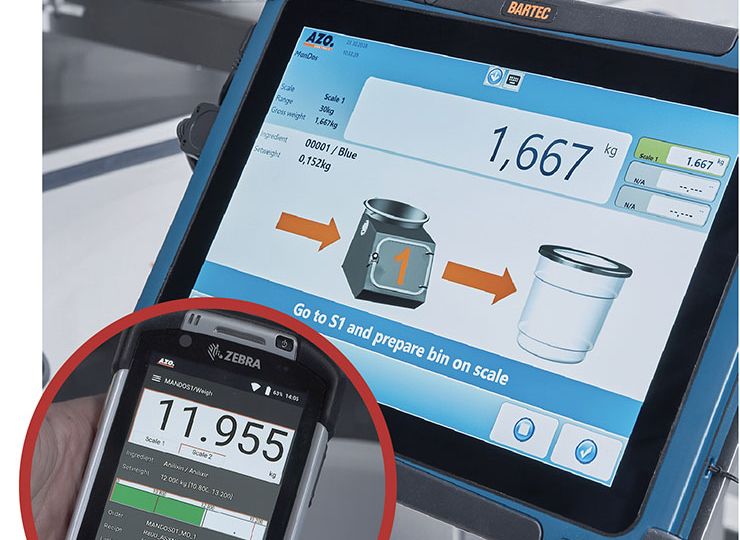
From the reception of ingredients to their storage, handling and recipe management, precise tracking of the raw materials going into formulations is best kept automatically, to ensure process accuracy.
Product quality requirements are increasingly growing in complexity, as the variety of recipes and ingredients used is expanding. Using more types of raw materials creates higher requirements in the area of raw material logistics, in supplying them and in changing them. Other requirements also stem from avoiding cross-contamination. Modern production control systems must provide solutions for all these necessities.
A complete solution
“Integrated warehouse management, recipe management and order control, as well as the tracking of raw material batches and avoiding operator errors are the focus of the KASTOR production control system,” explains Hendrik Langner, Automation, Sales and Consulting at AZO GmbH & Co. KG. This software tracks all raw material inputs throughout the workflow, starting with their transfer to the production area and including all relevant operating points such as material refilling, manual weighing and addition. “The entire area of dough production is documented, each raw material batch can be tracked. In the end, a log of the entire process is compiled,” Langner highlights.
AZO GmbH & Co. KG automates and documents raw material logistics in bakery production, for which it provides both specialized technology and controls.
KASTOR is a product family consisting of various functional modules that can be combined to a complete solution according to specific requirements. The modules can be used flexibly from incoming goods to manual weighing (with the ManDos) or the automatic KASTOR batch modules, up to the transfer to ovens and packaging.
To control dosing accuracy, the best dosing method has to be selected according to the characteristics of the raw materials: the gravimetric system works best for powders, while liquids are normally metered with electromagnetic or Coriolis flowmeters – the former for conductive substances, and the latter for non-conductive materials. For the different dosing methods, parameters such as the density/bulk must be stored, explains Langner. “For user guidance, various methods are used, in addition to classic recipe sequence controls. User guidance is mandatory at all process points with user intervention. Wizards with an integrated plausibility check are used. Mobile operating devices support the operators directly in the individual work areas,” he recommends.
User input is often simplified by barcode-supported processes, which helps avoid operator input errors. The same system usually works to track raw materials throughout the plant. For intermediate containers, labeling is used. All operating steps are logged, to ensure the traceability of the process.
Aside from the classing weighing systems used for large components, which uses hopper scales for the materials conveyed from external silos, there are several ways to automate raw material handling.
Special weighing systems for small components, such as the AZO COMPONENTER® Step are used, for example. Exchangeable containers used on an AZO Dosinenter® are another solution, usually adopted when raw materials are changed frequently, the specialist illustrates. All these solutions can be integrated into a total solution via KASTOR production control system.
Temperature control starts with recording the initial readings of the raw materials, which is done via sensors placed in the storage area. During production, “the temperature of the dough is calculated by measuring the water temperature before the corresponding dosing. Here, readjustment can take place over several dough batches,” Langner explains.
KASTOR: the features
In addition to the list of raw materials with the corresponding target values, KASTOR Recipe Management also contains a workflow that controls the recipe creation process. “If an ERP system specifies the target values of the raw materials (bill of material), this is combined with the corresponding workflow. This enables the integration of the production system with the customer’s ERP system,” he elaborates. Continuous automated data flows can be achieved in this way, to simplify handling.
The operations can be carried out with KASTOR centrally, via a control room, or decentralized, via operating points in the plant. To better serve a higher automation level of systems running with fewer employees, mobile operating devices such as PDAs or tablets can also be used.
The added value of the KASTOR is that it incorporates MES functions beyond the production process: “Order management, material management, tracking and tracing and interfaces to the ERP system or the downstream production processes are possible,” AZO’s specialist explains. KASTOR can also be used as a plant-wide MES system across the entire plant.
KASTOR also includes functions for the management of material pre-planning. The MES analyses the production orders according to their material requirements, taking into account the status of each ingredient stored in the plant, in silos, or other containers. The intermediate products already available are also taken into account. “The needed quantities can be requested from the customer’s high-bay warehouse. Here, interfaces to the warehouse can again guarantee an automatic and thus error-free data flow,” Langner explains.
The KASTOR DataCockpit feature uses the data production process data to relay the process accurately, which indicates the potential for optimization. “For example, changes in raw material properties can have an impact on dosing accuracy. If there are several metering errors recorded for a raw material, this can be visualized, providing valuable information on how to adjust the metering parameters. In this way, the data can provide real added value for the plant operator and the plant can be operated as optimally as possible,” he illustrates.

© AZO GmbH & Co. KG.
The article is part of an extended feature, which was originally published in [BBI 2 – 2022]. Read the full article in the magazine:


